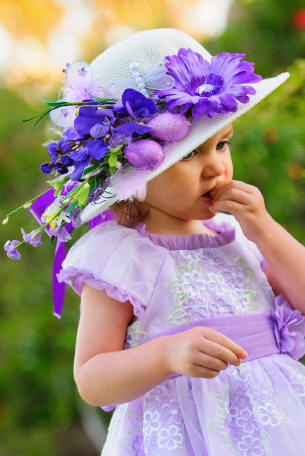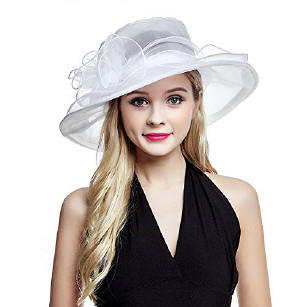Valerie McPhail
MSMU Class of 2015
 (3/2020) Like our habits, do trends die-hard? My understanding is that they never seem to escape us, just return in season, and resurface to the forefront of our interest, or shall I dare say our fashion obsessions. I wonder where the Easter hat, a garment of vibrant fashion
reference and cultural history, fits into the case for Spring fashion. For unlike the trend, the Easter hat is an accessory advanced by the Church, in accordance with scripture interpretation. Its reach into mainstream fashion has not found entirely transferable. Though a fashion statement by definition of a garment that is unlike anything else beyond the Kentucky Derby garb
- feathers, bright colors, and classic top hat shape, the Easter hat appeals to current fashion, as nothing is more individual than a sense of personal style.
(3/2020) Like our habits, do trends die-hard? My understanding is that they never seem to escape us, just return in season, and resurface to the forefront of our interest, or shall I dare say our fashion obsessions. I wonder where the Easter hat, a garment of vibrant fashion
reference and cultural history, fits into the case for Spring fashion. For unlike the trend, the Easter hat is an accessory advanced by the Church, in accordance with scripture interpretation. Its reach into mainstream fashion has not found entirely transferable. Though a fashion statement by definition of a garment that is unlike anything else beyond the Kentucky Derby garb
- feathers, bright colors, and classic top hat shape, the Easter hat appeals to current fashion, as nothing is more individual than a sense of personal style.
Church Attire
To engage fashion, in its fullness of superficiality and vain, within the Church, is a beautiful expression. Fashion's presence in the non-secular is proof that the industry thrives, at best, when engaged within culture, and the affection of the human heart. The later is where personal style is explored, and even in the Church, an institution built on
tradition, can be acknowledged and celebrated. Therefore, the Easter hat, also referred to as the Easter bonnet, is not a religious symbol. Rather, representative of the Christian community's commitment to tradition's interpretation of the Bible. History shares that the Easter bonnet was action of the Word, 1 Corinthians 11: 5-6, understanding its guidance to instruct a woman
to cover her head when worshiping God.
 In the book, The Penguin Guide to the Superstitions of Britain and Ireland, Jennifer Westwood, and Stephen Roud, further discuss the subject of new garments worn on Easter Sunday. Their conclusions develop conversation around larger topics on spirituality. "It [the Easter bonnet]
represents the tail-end of a tradition of wearing new clothes at Easter, in harmony with the renewal of the year and the promise of spiritual renewal and redemption." ("Easter bonnet") A consideration for expressing one's spirituality through new fashion, at Church, is rare to today's modern culture.
In the book, The Penguin Guide to the Superstitions of Britain and Ireland, Jennifer Westwood, and Stephen Roud, further discuss the subject of new garments worn on Easter Sunday. Their conclusions develop conversation around larger topics on spirituality. "It [the Easter bonnet]
represents the tail-end of a tradition of wearing new clothes at Easter, in harmony with the renewal of the year and the promise of spiritual renewal and redemption." ("Easter bonnet") A consideration for expressing one's spirituality through new fashion, at Church, is rare to today's modern culture.
Even the presence of "Sunday's best," the act of dressing-up for Mass or service, is a fading concept to the local Church. A few years ago, my parents spent a weekend in New York to visit my twin sister and me; our weekend agenda included Church on Sunday. We showed up to Hammerstein Ballroom, where my home church was hosting service at the time, I
wore jeans and a graphic tee, and my mom, heels and a beautiful navy and pink, Spring dress. As millennials raced around the venue in skinny black jeans, fedoras, and Vans sneakers, my mom blatantly communicated through fashion, that she was from out of town. Acknowledging the difference, I inquired on why she chooses to dress up for service. She answered: " She wants to give
God her best." Though the matchbox hat, pearls, shawls, and pencil skirt fashion, no longer defines mandatory attire, the desire to dress with honor to God, and in response to spiritual rebirth is impressionable fashion as the most intimate act of personal expression.
The New York Parade
New York City celebrates Easter with a Parade on Easter Sunday each year. Unlike the parades recorded in the Bible, such as Palm Sunday, this is a fashionable event to the city. From St. Patrick's Cathedral to 55th Street, bonnets, top hats, and unique headpieces are typically accompanied by costume. In a 2018 interview with Racked, Tenth Street Hats
CEO, Carson Finkle shared the history of the parade,
"The first Easter parade was in New York after the Civil War. People had basically been dressed more like they were in mourning, in black, but that Easter they really wanted to come in bright clothes and Easter hats. The history and the tradition behind the hats really stems from that. For years, people were known to buy new hats, their first hats of
the year, to wear for Easter. It's a complete renewal for that year — new hat, new wardrobe."
The parade offers opportunity for public expression, hats dressed like Easter baskets, flower crowns, and accessories honoring different cultures are represented. Each year, the fashion capital of America, the Easter bonnet, is fashioned. To have the hat representing the season of rebirth at an annual parade in midtown New York City is noteworthy of
trending status.
From Runway to Everyday
Whereas women wear bonnets for Easter, Finkle, from Tenth Street Hats, said that the men's choice is the fedora. The Easter hat has evolved, is the woman in the fedora - a popular New York style, a sign of fluidity in fashion? But that's just spottings of everyday life in the city. At fashion week, Temporary London, and Erdem sent designs that appeared
to be the closest manifestation to Easter hat. Boxy top, a wide cylinder lid, and ribboned harness informed the design. In New York, the Spring hat showed in full-spectrum. Marc Jacobs led the statement of the season through showcasing a variety of at his show, which habitually closes New York Fashion Week. Across the world, fashion brands interpreted differently. For others,
spring brought floppy hats by Oscar de la Renta, and straw hats by Rosie Assoulin. Few and far between were the go-go caps from Sportmax, Salvatore Ferragamo's baseball caps, and stunning, the cowboy hat at Chanel.
For Spring 2020, the new bonnet is the baby bonnet: the bucket hat. R13 printed the cap with neon-colored animal prints and fiery flames, while Anna Sui showed a more feminine touch with floral and check-printed patterns of Easter colors - tangerine, lavendar, and baby blue. On the Tenth Street Hats website, the brand informs, "Historically, Easter
represents literal resurrection. Over the years, the meaning of the holiday has evolved and shaped itself around more modern traditions. The Easter hat — typically a bonnet or an elegant church hat — has itself evolved along with the holiday. " Though Macy's still sells the traditional Easter hat, adorned with feathers and flowers, online, fashion is progressing to new
thought on the accessory. From the runway to brick-and-mortar, even online, the Easter hat carries an influence on springtime fashion.
The Easter hat is an accessory symbolic of new beginnings, shedding the past heaviness of winter and embracing Spring through fashionable expression. As fashion evolves, alternations are made repeatedly, but the heart of style is steadfast, uncharacteristically deviant from its function, irrespective of how outlandish, Avante Garde, and experimental
the designs present. The hat, bonnet, and cap can represent the Easter hat. Fashion welcomes expression in all forms. And God, loves our devotion, even if it is represented in the material.